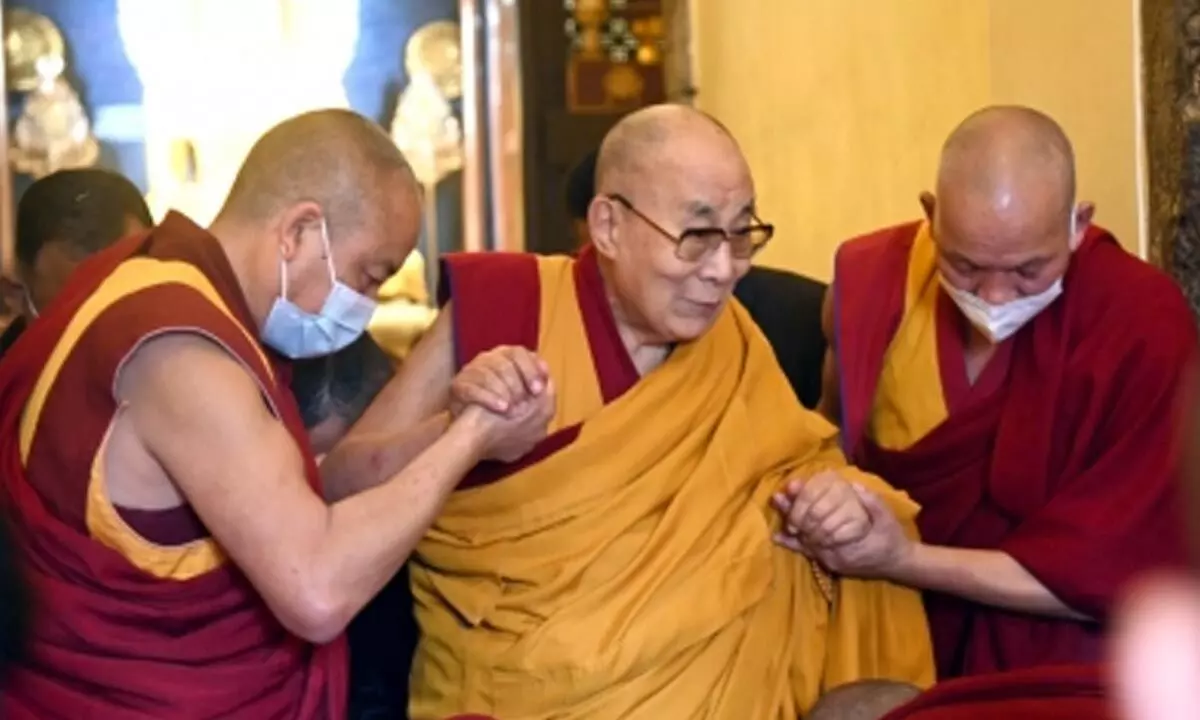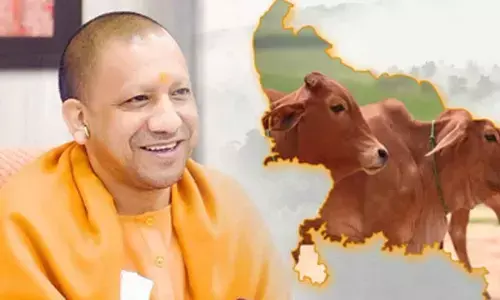Ageing Dalai Lama attracts huge crowds to Buddhist sacred site

Ageing Dalai Lama attracts huge crowds to Buddhist sacred site
The Dalai Lama, Tibet's spiritual leader, recently concluded a three-day speaking engagement at Bodhgaya
The Dalai Lama, Tibet's spiritual leader, recently concluded a three-day speaking engagement at Bodhgaya, known as the 'land of enlightenment' that has attracted over 100,000 mainly Tibetans from across the world.
The huge response surprised the organisers, as the event coincided with the Indian media talking about a new wave of Covid sweeping the country.
Covid was far from the mind of pilgrims and devotees -- even though many wore face masks as requested by the local government authorities.
According to police estimates, about 100,000 people converged at a large open field next to the sacred Mahabodhi Temple, where the 'Bo' tree under which Gautama Buddha attained enlightenment is located.
Tibetan writer and activist Tenzin Tsundue, who has lived in Dharamsala, the home of the Dalai Lama, for the past four decades, followed him to Bodhgaya. He thinks the main reason for the large crowds is that "Covid has suppressed people's aspirations", and this is an opportunity to get back to spiritual and family bonding.
"Not everybody can go to Dharmsala. But this space attracts you because you not only get to see the Dalai Lama and get his blessing; there is also the Bodhgaya temple. And it is surrounded by so many pilgrimage sites," he said.
Before the coronavirus pandemic, about half a million pilgrims were visiting Bodhgaya to pay homage to the scared �Bo' tree that gave shelter for the Buddha to attain enlightenment.
The Mahabodhi temple was declared a UNESCO World Heritage Site in 2002, and it is the most sacred site of pilgrimage for Buddhists from across the world, like the Vatican is for Catholics or Mecca is for Muslims.
Around the Mahabodhi temple complex are many temples depicting the diverse culture and architecture of Buddhist countries and communities, such as those from Thailand, Sri Lanka, Myanmar, Bhutan, Mongolia, China, Tibet, Nepal, Japan and Laos. Without a local Buddhist community in Bodhgaya (most of the population here are Hindus and Muslims), the monasteries here are dependent on foreign pilgrims for their upkeep.
The Dalai Lama's visit has provided a much-needed fillip to pilgrim tourism here. Most of the monasteries were closed to visitors for almost two years, Nangzey Dorjee, secretary of the Bodhgaya Temple Management Committee (BTMC), said.
The Bihar government constituted a committee to step in to help the monasteries.
"Main source of income (for monasteries) is a donation. Donation from the devotees this was their sole maintenance income. Other than now and then, there is no provision of funding from the government side," he said.
"All temples function on the basis of the devotees' offerings (so) there were deadly problems (and in addition) local people had no work. All other temples depend on this temple," added Dorjee.
The large number of pilgrims visiting here does not mean the local temples get most of their donations. There are also rows of donation booths for monasteries and other Tibetan Buddhist institutions across India, Nepal, Bhutan, lining up the street opposite Mahabodhi Temple.
"Whenever there is any prayer gathering like this, donations are natural because people think this is a way to contribute from their hard-earned money, to contribute towards monasteries where young children who study Buddhism are being nurtured. So, you see, it's always a generous effort by people to contribute to Buddhist education and nurturing of young monks," explained Tsundue.
People were giving generously at many of the stalls, with volunteers issuing receipts for each donation. "Every family would make sure that they split 1000 or 10,000 or one lakh rupees into small changes," Tsundue said.
Hence, local vendors were doing brisk business selling bundles of 10-, -20-, or -50-rupee notes to devotees in exchange for those of larger denominations. This enabled pilgrims to make even smaller donations.
Built around the monasteries is a typical pilgrim tourism town with hundreds of hotels, cafes, souvenirs and other shops, heaps of street vendors and a huge number of beggars who are attracted to Bodhgaya because of the compassionate mindset of the pilgrims visiting here.
Souvenir shop owner Lolu, who was doing brisk business, said, "during the pandemic, my shop was closed (and) I even didn't have enough money to eat", and added with a smile "Dalai Lama has brought good karma for me".
"Dalai Lama has been coming here often (before Covid)," said Dorjee. "He is one of the rare figures and not only for Buddhism; he is also a world figure, he is exceptional."
Dalai Lama, now 87, arrived at the grounds in a golf cart and had to be assisted by two monks to walk to the stage and be seated. However, his mind seems alert, and so is his thinking faculty. He delivered a lecture of more than an hour each day without any hesitancies or stammering.
At the back of the minds of many of the Tibetan devotees here seemed to be for how long they could hear his teachings and be in the vicinity of his charismatic personality.
Reflecting on the global attraction of Tibetan Buddhism and culture today and the fact that there were many non-Tibetans here, such as westerners, Vietnamese, Thais and many ethnic Chinese from Southeast Asia, Professor Geshe Ngawang Samten, vice chancellor of the Central Tibetan University in Sarnath in India, said that it is because of Tibetans not having a home of their own that its Buddhist traditions have spread far and wide.
Professor Samten also pointed to a special quality of Dalai Lama's teachings that elicits worldwide appeal and admiration. "He attracts (attention) because he is very rational; his mind is very scientific," he said.
"The way he addresses the issues either in individual life or in social life, (he does it) through understanding the situation and providing a tool or solution that can be implemented through the transformation of a person (or) the transformation of a social system (or) through the transformation of the education system."
"That is what people appreciate. He is not in favour of propaganda and propagation of Buddhism," said Professor Samten. "Always he advises that don't propagate it, do not convert other communities and people who are already within a religious kind of system. So that is his kind of attitude."

















